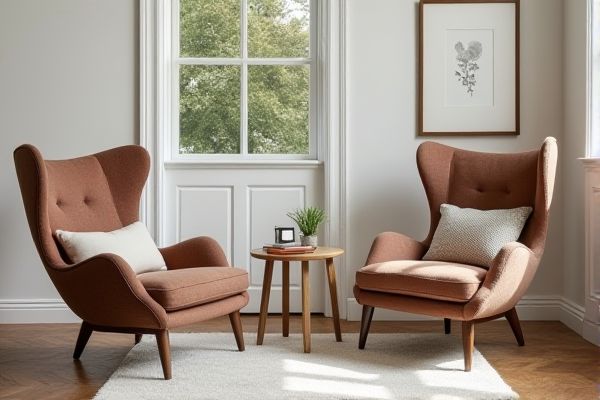
A tall-backed chair provides superior lumbar support and encourages proper posture, making it ideal for prolonged sitting sessions, while a low-backed chair promotes greater mobility and is often preferred for casual or shorter use. Explore the rest of the article to determine which option best suits your comfort needs and lifestyle.
Table of Comparison
| Feature | Tall-Backed Chair | Low-Backed Chair |
|---|---|---|
| Support | Full upper back and neck support | Lower back support only |
| Comfort | Enhanced comfort for long sitting | Suitable for short to moderate sitting |
| Design | More formal and ergonomic design | Compact and minimalist design |
| Usage | Ideal for office, gaming, and executive use | Best for casual seating and dining |
| Size | Larger footprint and taller height | Smaller footprint, easier to move |
| Price | Generally higher price range | Typically more affordable |
Introduction: Understanding Chair Back Heights
Tall-backed chairs provide extensive upper body support, promoting better posture and reducing shoulder strain during prolonged sitting. Low-backed chairs encourage greater mobility and freedom of movement, making them suitable for dynamic work environments where flexibility is essential. Selecting the appropriate back height depends on individual ergonomic needs and the intended use of the chair.
Key Differences Between Tall-Backed and Low-Backed Chairs
Tall-backed chairs provide enhanced lumbar support and promote better posture by supporting the entire spine, making them ideal for prolonged sitting sessions. Low-backed chairs offer greater freedom of movement and a minimalist design, often favored in casual or collaborative settings. Your choice between these chair types should consider comfort, ergonomics, and the specific environment where the chair will be used.
Ergonomic Benefits of Tall-Backed Chairs
Tall-backed chairs provide superior ergonomic support by promoting proper spinal alignment and reducing strain on the neck and shoulders, which can help prevent chronic pain during extended sitting sessions. They often feature adjustable height and lumbar support, allowing you to customize the chair to fit your body shape and maintain a healthy posture. Unlike low-backed chairs, tall-backed designs encourage better circulation and reduce fatigue, making them ideal for long hours of office work or gaming.
Comfort and Support in Low-Backed Chairs
Low-backed chairs provide greater freedom of movement while offering moderate lumbar support, making them suitable for short-term seating needs. Their design promotes ventilation and reduces heat build-up, enhancing comfort during extended use in warmer environments. You can improve comfort by selecting low-backed chairs with ergonomic cushioning tailored to support your lower back effectively.
Aesthetic Appeal: Tall-Backed vs Low-Backed Designs
Tall-backed chairs offer a commanding aesthetic with their elongated silhouette, often enhancing the grandeur of formal dining rooms or executive offices. Low-backed chairs, in contrast, provide a sleek, minimalist look that complements modern and casual interiors by emphasizing open space and clean lines. The choice between tall-backed and low-backed designs significantly influences the room's visual dynamics and perceived comfort level.
Suitability for Different Spaces and Uses
Tall-backed chairs provide excellent support and create a formal, imposing presence ideal for spacious dining rooms or offices where posture is important. Low-backed chairs suit smaller spaces or casual settings, offering a sleek design that maintains openness and flexibility without overwhelming the room. Your choice depends on balancing comfort, style, and the spatial dynamics of your environment.
Posture and Health Implications
Tall-backed chairs promote better posture by supporting the entire spine, reducing strain on the neck and lower back, which helps prevent musculoskeletal problems. Low-backed chairs often result in slouching or leaning forward, increasing the risk of spinal misalignment and chronic back pain. Ergonomic design in tall-backed chairs enhances comfort and reduces fatigue during prolonged sitting, benefiting overall spinal health.
Tall-Backed Chairs for Office and Home Settings
Tall-backed chairs offer superior ergonomic support by promoting proper spine alignment and reducing back strain during prolonged sitting, ideal for both office and home environments. Their extended backrest provides enhanced comfort, helping you maintain focus and productivity throughout your workday. Choosing a tall-backed chair can improve posture and prevent discomfort, making it a valuable addition to your workspace.
Low-Backed Chairs in Modern Interior Design
Low-backed chairs in modern interior design emphasize minimalism and openness, enhancing the sense of space in contemporary settings. Their sleek profiles and understated presence complement clean lines and neutral palettes, making them ideal for creating airy, uncluttered environments. These chairs also offer ergonomic support while maintaining a lightweight aesthetic, contributing to versatile living and office spaces.
Choosing the Right Chair for Your Needs
Tall-backed chairs provide enhanced neck and upper back support, making them ideal for prolonged sitting sessions and ergonomic comfort. Low-backed chairs offer greater mobility and a lighter frame, suited for shorter uses or spaces requiring frequent movement. Consider your daily tasks and posture requirements to select a chair that optimally balances support, flexibility, and overall comfort.
 homyna.com
homyna.com